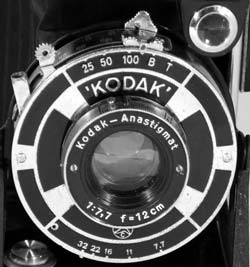Kodak Junior 616
Specification

| Manufacturer | : | Kodak |
|---|---|---|
| Produced | : | UK 1933-1940 |
| Classification | : | Medium Format |
| Body Type | : | Folding Bed |
| Bellows Deployment | : | Self Erecting |
| Construction | : | Metal |
| Film Type | : | 616 |
| Film Width | : | 70mm |
| ImageSize | : | 2½ x 4¼ in |
| No. of Images | : | 8 |
| Lens Type | : | Kodak Anastigmat |
| Focal Length | : | 120mm |
| Focus Type | : | Variable |
| Focal Range | : | 1.5m - inf. |
| Aperture Type | : | Iris |
| Aperture | : | f/7.7 - f/32 |
| Shutter Type | : | Kodak K |
| Shutter Speeds | : | T,B, I(1/25,1/50,1/100 sec) |
| Size Closed (w x h x d) | : | 95 x 185 x 39 mm |
| Size Open (w x h x d) | : | 125 x 185 x 145 mm |
| Weight | : | 710g |
Art Deco Credentials
![]()
![]()
![]()
![]()
Significant: Pronounced and self evident
- Produced during the main Art Deco period.
- Geometric black and chrome faceplate design.
- Chrome struts with vertical embossed pattern.
- Chrome edging to body.
- Bellows embossed with lines.
- Body leatherette embossed with linear pattern.
- Concentric circles on back of tripod boss.
- Chrome winder, tripod boss and film door latch.
Description

A number of variations were built in Britain, Germany and America which all have the same name. This British version, which is practically identical to the German-built model, was in production between 1933 and 1940. It has a round Art Deco shutter faceplate, straight ornate embossed struts, a 12cm f/7.7 Kodak Anastigmat lens and is covered in leather on a metal case. It has two viewfinders. The folding finder is attached to the body. A small swivelling brilliant finder is connected to the shutter housing. The camera is opened by lifting the table stand lever and pulling on the self-erecting bed. The camera is closed by pressing on a quick-release bar at the front of the bed. The Junior 616 takes six 2½ x 4¼ inch exposures on a roll of 616 film.
How to Use
This camera takes uses 616 film which is not available anymore except as expired films. This means that the camera needs modification to take 120 film. Modification is fairly straight forward and will easily give 5 'panoramic' exposures producing 2¼ x 4¼ inch negatives. Check out my page on 'Conversion of a 616 camera to take 120 film'.
When you have completed the conversion to 120 film, if you don't want to bother with an exposure meter, follow the guide shown. It is based on the 'Sunny 16' rule. Film is so forgiving and will produce acceptable results even when overexposed by 2 or 3 stops or underexposed by 1 stop.
Shutter speeds are 1/25s, 1/50s and 1/100s although the accuracy is not guaranteed. The aperture range is f/7.7 to f/32
Remember that the exposure guide in the camera user manual may not be helpful as it is based on the use of old film with a low ISO value.
The tables assume that the sun is at least 30 degrees above the horizon - that's 10am - 5pm on a summer's day(May-August) in the UK.
If you are not sure about the light level, err on the side of overexposure - i.e. assume the smaller f number.
Where there is a choice, a larger f number will give a larger depth of field.
For the slower speeds, you may need a tripod to stop blur through shake.
Using ISO 100/125 film
| Weather Conditions | Shadow Detail | Shutter Speed (s) | ||
|---|---|---|---|---|
| 1/25 | 1/50 | 1/100 | ||
 Sunny SunnySnow/Sand | Dark with sharp edges | - | f/32 | f/22 |
 Sunny Sunny | Distinct | f/32 | f/22 | f/16 |
 Slight Overcast Slight Overcast | Soft around edges | f/22 | f/16 | f/11 |
 Overcast Overcast | Barely visible | f/16 | f/11 | f/7.7 |
 Heavy Overcast Heavy Overcast | None | f/11 | f/7.7 | - |
 Open Shade Open Shade/Sunset | None | f/7.7 | - | - |